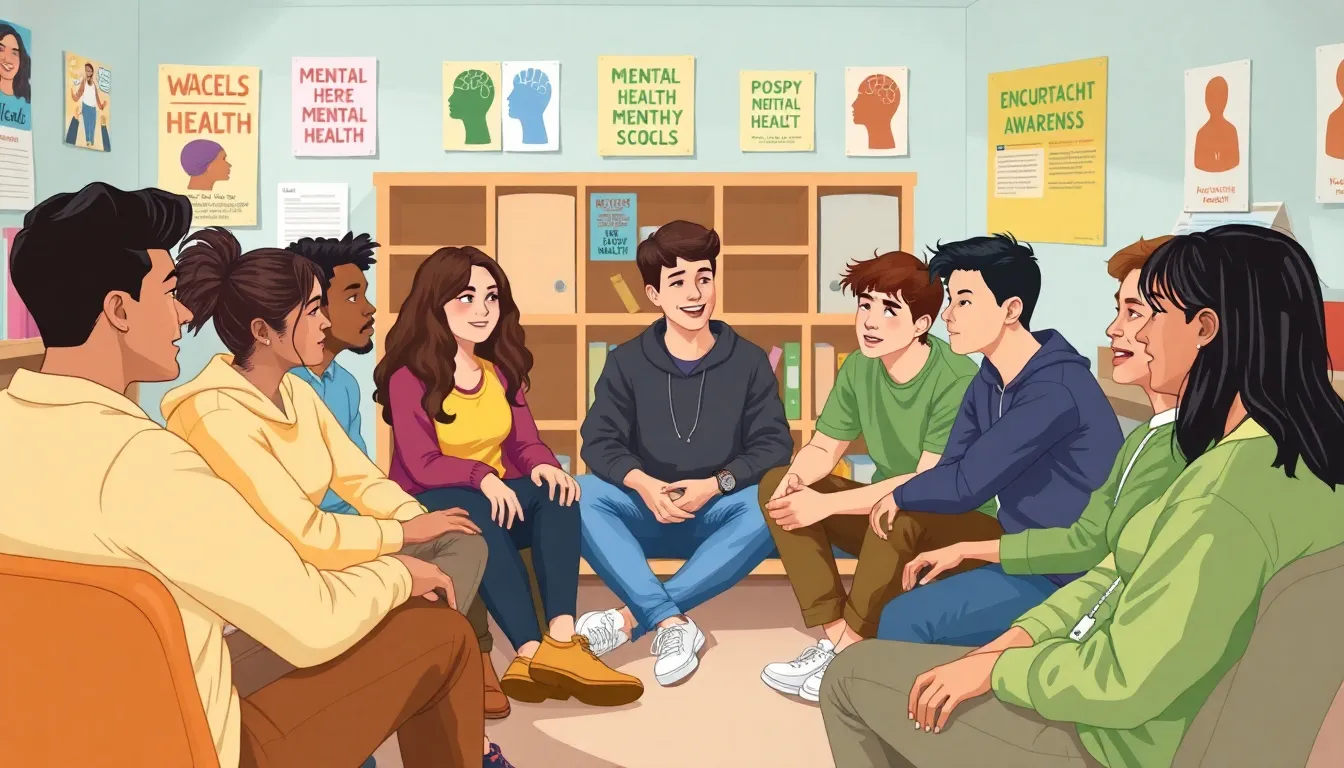Table of Contents
ToggleNavigating the teenage years can feel like trying to solve a Rubik’s Cube blindfolded—frustrating and confusing. With the pressures of school, social media, and the ever-elusive quest for identity, mental health often takes a backseat. Yet, it’s crucial for teens to know they’re not alone in this chaotic journey.
Support is out there, and it doesn’t have to come with a side of awkwardness. From peer-led initiatives to professional counseling, the resources available today are more accessible than ever. Understanding the importance of mental health support can be the first step toward a brighter, more balanced future. So let’s dive into the world of teen mental health support and discover how to turn those frowns upside down—because everyone deserves a little help in their corner.
Understanding Teen Mental Health
Teen mental health is a crucial aspect of overall well-being, encompassing emotional and psychological challenges common during adolescence. Many factors influence mental health during these years, including academic pressure, social dynamics, and self-identity exploration.
Common Issues Faced by Teens
Anxiety affects a significant number of teenagers, often stemming from academic demands and social pressures. Depression manifests in feelings of sadness and hopelessness, leading to a decline in motivation and energy. Eating disorders can develop due to societal beauty standards and peer influence, impacting physical and mental health. Substance abuse may arise as teens seek relief from their emotional struggles. Bullying, whether in-person or online, exacerbates feelings of isolation and worthlessness. Awareness of these issues is vital for early intervention and support.
The Importance of Mental Health Support
Mental health support plays a key role in helping teenagers navigate their challenges. Access to resources like counseling can provide safe spaces for expression and coping strategies. Peer-led initiatives encourage open discussions and foster community, helping teens feel less isolated. Support networks can enhance resilience, equipping teens with the tools to handle stress and adversity. Schools and families contribute by promoting awareness and encouraging conversations surrounding mental health. Prioritizing support sets the foundation for positive mental health outcomes and overall well-being.
Types of Teen Mental Health Support

Various options exist to support teen mental health, ensuring access to necessary assistance. Both professional help and peer support programs play essential roles in fostering mental wellness.
Professional Help
Therapists, counselors, and psychologists offer vital resources for teens facing mental health challenges. Regular sessions with a qualified professional can help address issues like anxiety and depression. Schools often provide access to on-campus counselors, making support more accessible. Teletherapy options have emerged, allowing teens to receive help from the comfort of their homes. Utilizing these services promotes a healthier mindset and equips teens with coping strategies. Leadership organizations emphasize the importance of reaching out for professional guidance.
Peer Support Programs
Peer-led initiatives create safe environments for teens to share experiences and feelings. These programs often promote open conversations about mental health challenges, reducing stigma and fostering community. Schools and local organizations run groups where peers provide empathy and understanding. By connecting with others who face similar struggles, teens experience validation and support. Research shows that peer support significantly enhances resilience and overall well-being. Many teens find it easier to discuss their feelings within these supportive networks, making them crucial for mental health.
Role of Parents and Guardians
Parents and guardians play a crucial role in supporting teen mental health. Their involvement can significantly impact a teen’s well-being and resilience.
Identifying Signs of Distress
Noticing signs of distress starts with observing changes in behavior. Parents may see shifts in mood, withdrawal from social activities, or alterations in sleep patterns. Sudden declines in academic performance often signal underlying issues. Teens might express feelings of sadness, anxiety, or irritability. Additionally, withdrawing from family interactions can be a red flag. Recognizing these signs early allows parents to approach their teens and offer necessary support. Keeping an open eye on these subtle indicators enhances the likelihood of timely intervention.
Effective Communication Techniques
Connecting effectively requires intentional strategies. Parents should create safe spaces for conversation, using open-ended questions to encourage dialogue. Actively listening without interrupting fosters trust and understanding. It’s important to validate feelings rather than dismiss them, showing empathy towards the teen’s experiences. Remaining calm during discussions aids in avoiding escalation, promoting a supportive environment. Consistent check-ins not only show care but also reinforce the idea that it’s okay to share struggles. By modeling respectful communication, parents teach valuable skills that benefit their teens in various relationships.
The Impact of Social Media
Social media has a profound influence on teen mental health. It offers platforms for connection, allowing teens to communicate and share experiences with peers.
Positive Aspects
Social media fosters a sense of community. Teens can find support networks that validate their feelings and experiences. Instagram and TikTok, for instance, provide spaces for sharing mental health stories and resources. This sharing can reduce feelings of isolation and help teens feel understood. Engagement with mental health advocacy pages often inspires positive self-image and encourages self-care practices. Many teenagers access mental health information through these platforms, promoting awareness and proactive health behaviors.
Risks and Challenges
Despite its benefits, social media poses risks to mental health. Constant exposure to curated lifestyles can lead to comparisons, potentially causing anxiety and depression. Cyberbullying remains a significant issue, negatively affecting self-esteem and emotional well-being. Additionally, the pressure to maintain a perfect online persona can be overwhelming. Excessive screen time has correlational links to sleep disturbances and reduced physical activities, negatively impacting mental health. Ultimately, balancing social media use is essential for maintaining healthy mental well-being among teens.
Supporting teen mental health is essential for navigating the complexities of adolescence. By recognizing the signs of distress and fostering open communication, parents and guardians can create a nurturing environment. Utilizing both professional resources and peer-led initiatives enhances resilience and promotes well-being among teens.
It’s vital for schools and families to prioritize mental health awareness, ensuring that teens feel safe and supported in their journeys. As they face the pressures of modern life, a strong support system can make all the difference in achieving a balanced and positive future. Embracing these resources empowers teens to thrive and fosters a healthier community overall.






